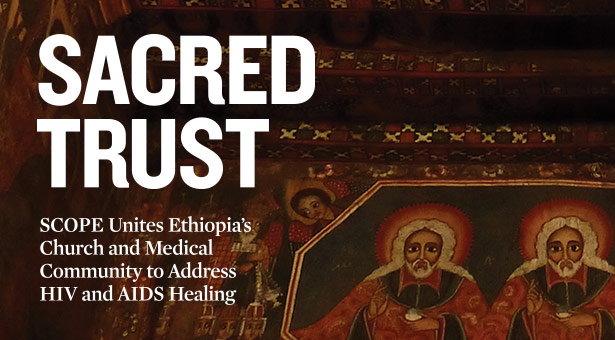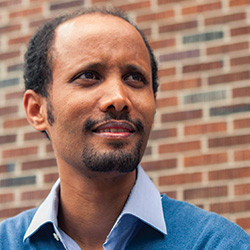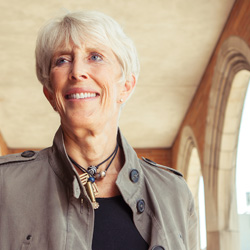 Members of the Trinity look down from the ceiling of Debre Birhan Selassie Church in Gondar, Ethiopia. An estimated 80 to 90 percent of people in the Gondar region belong to the Ethiopian Orthodox Church.
Members of the Trinity look down from the ceiling of Debre Birhan Selassie Church in Gondar, Ethiopia. An estimated 80 to 90 percent of people in the Gondar region belong to the Ethiopian Orthodox Church.
By Laura Onstot ’03 | Photos by Peggy Sarjeant
When Zerai Asgedom ’07 was growing up in Ethiopia, people didn’t talk openly about any aspect of reproduction. In particular, people kept quiet about the growing AIDS epidemic. But when he returned to his country last January — more than a decade after he left for school in the U.S. — that had changed. Discussing AIDS was now becoming acceptable.
“You have to deal with it,” Asgedom says.
There is a very good reason people are beginning to talk about AIDS in Ethiopia. According to a 2012 United Nations report, nearly 800,000 Ethiopians are living with HIV and AIDS, and nearly 1 million children are orphans because their parents fell victim to the disease.
Asgedom, who earned a nursing degree from Seattle Pacific University, went back to Ethiopia for four months beginning in January 2013 with SCOPE, a nonprofit organization. His assignment was to identify clinics in the northern part of the country that had the doctors, nurses, and resources required to create a program to test pregnant women for HIV. If they tested positive, they would need to begin treatment to avoid passing the virus to their newborn babies.
 SCOPE Fellow Zerai Asgedom ’07 traveled to Ethiopia to help design a project that would use the Ethiopian Orthodox Church’s influence to help prevent mother-to-child transmission of HIV.
SCOPE Fellow Zerai Asgedom ’07 traveled to Ethiopia to help design a project that would use the Ethiopian Orthodox Church’s influence to help prevent mother-to-child transmission of HIV.![]() View more photos
View more photos
Asgedom was an ideal candidate for this fellowship with SCOPE, which means Strengthening Care Opportunities through Partnerships in Ethiopia. SCOPE exists to bridge the gap between the medical community and the church, and in so doing use the reach of Ethiopia’s faith communities to help more people access treatment for HIV and AIDS. Asgedom has medical training, speaks Amharic, and shares the Ethiopian Orthodox faith of nearly 44 percent of the country.
But still he faced challenges. “Being away from the culture for a while, it was not easy to get back into it for the first couple of weeks,” he says. For instance, Asgedom found himself having to get used to how close together people live in Ethiopia. “In the United States, there’s personal space,” he explains.
Even as he adjusted to the lack of elbow room, Asgedom began working to strengthen partnerships between the Ethiopian Orthodox Church and the local health care centers. It wasn’t a simple task.
Faith is a cornerstone of life for nearly all people in Ethiopia. In the northern Gondar region, where the SCOPE project is focused, Getahun Asres Alemie, a medical doctor from the University of Gondar, estimates that 80 to 90 percent of the population belongs to the Ethiopian Orthodox Church.
Ethiopia has more than 500,000 priests. By contrast, a 2008 report put the number of doctors at 1,600, though the country has been aggressively trying to increase that number. The church has a far broader and deeper reach than medical professionals.
“Instead of talking to a physician, to a health care provider, people prefer to talk to their soul fathers — their priests,” Getahun says.
In some cases, this can create a conflict between faith and medicine. Nancy Andrews ’86, who founded SCOPE, recalls meeting the staff of an AIDS clinic that had recently received anti-retroviral drugs. “The staff members were very pleased that they had gotten 16 people on these drugs and that the patients were doing very well,” Andrews says.
But what happened next was disheartening. The 16 people returned to their communities and to their churches, and stopped taking the drugs in favor of the healing rituals of the church. For instance, says Judd Walson — a medical doctor on staff at the University of Washington who is working with SCOPE and has spent much of his career working in East Africa — people have historically looked to holy water as a source of healing.
“This clearly showed us the disconnect between the church and the medical community in Ethiopia,” Andrews says. And it demonstrated the need for an initiative like SCOPE.
It was a disconnect between American churches and the suffering caused by AIDS that first prompted Andrews to begin SCOPE. She traces the project’s origins to a presentation she attended at University Presbyterian Church in 2006. A World Vision staffer was talking about the AIDS epidemic. “He said, ‘AIDS is the greatest humanitarian crisis of our era. 100 years from now, when people look back and ask what the church did, what will they say?’” Andrews recalls. “I looked around the room, and I thought, ‘We have a church of 4,000 people. You know, we could do something.’”
After the World Vision presentation, Andrews met with Ken Kierstead, UPC’s senior director of outreach, to tell him she wanted to respond to the challenge — and to help make their church a more active participant in the fight against HIV and AIDS. They considered the idea together and chose to focus on Ethiopia, where University Presbyterian was already supporting a doctor.
 Nancy Andrews, a former Microsoft employee who earned a computer science degree from SPU, founded SCOPE Health as a ministry of Seattle’s University Presbyterian Church.
Nancy Andrews, a former Microsoft employee who earned a computer science degree from SPU, founded SCOPE Health as a ministry of Seattle’s University Presbyterian Church.
Getting SCOPE off the ground became a matter of persistence and serendipity. Andrews notes the many connections that brought SCOPE to life, not the least of which was the prominent University of Washington AIDS researcher who happened to be her friend’s neighbor and who donated his expertise to the project. “We couldn’t have foreseen that these kinds of partnerships would develop,” Andrews says.
Those partnerships have become the heart of SCOPE’s mission. First, University Presbyterian Church partnered with the Department of Global Health at the UW to create SCOPE. Then, in a parallel structure halfway across the world, leaders of the Ethiopian Orthodox Church and medical staff at the University of Gondar joined in.
Before they could help overcome the divide between faith and medicine in Ethiopia, the American doctors and church leaders making up the initial SCOPE team had to establish their own partnership. They had to find ways to respect both the science and personal faith, and then take that mutual respect to Africa.
“It’s really not about making doctors feel better or making priests do better, it’s about patients,” says Walson.
“That’s why I’m working with the SCOPE project. The Ethiopian community is mostly composed of religious people — people who listen to their religion, people who practice their religion,” Getahun says. “I don’t know any previous projects working with the priests in terms of HIV and AIDS. For SCOPE to be able to do this project with the priests is innovative.”
In 2010, SCOPE launched one of its first projects with the Ethiopian Orthodox Church — an HIV-testing campaign. Andrews and Walson sat down with Kesis Dawit, a priest, and conceived the idea.
The church in Gondar had a collection of relics stored in what amounted to a monk’s bedroom. Silver and bronze crosses; old manuscripts, some on goatskin; and robes and hats from church patriarchs were tucked into the small space. Dawit suggested sprucing up the room and turning it into a public display, a small museum. The archbishop, Abune Elissa, agreed to invite people to come for the unveiling, and he gave SCOPE permission to host HIV testing and counseling in small tents nearby.
Perhaps most significant of all, Abune Elissa was the first person to get tested.
Walson attributes the success of the campaign in large part to the archbishop choosing to get tested publicly. “[The people] felt that if the religious leaders were advocating for [testing] then they would do it.”
“In three days, we tested 850 people, including the archbishop and 55 priests,” Andrews reports. “It proved that we — the clinics, the church, and the university — could work together.”
Zerai Asgedom worked with SCOPE’s newest project, which focuses on preventing mother-to-child HIV transmission. In 2011, as part of its global health strategy on HIV and AIDS, the World Health Organization established the goal of ending what’s also known as “vertical transmission” by 2015. It’s a lofty aim, Andrews says, but “if we could tag onto that goal, that could be really significant.”
When Asgedom arrived in Ethiopia, he set up a focus group where priests could learn more about the project and discuss their concerns. “They knew the community will listen to them more than they will listen to the health system,” he says.
There were areas of tension. The priests were hesitant to get involved in discussions of condom use, for instance. But they also challenged Asgedom on the topic of faith — not in God or the church leaders, but in the medical system he represented. “We have to have some sort of trust in the health care system that it won’t fail the people,” the priests said. “How confident are you in the health care system?”
The priests had good reason for their concerns. Some of the Ethiopian clinics Asgedom visited had no electricity. Another center didn’t have the necessary means of administering anti-retroviral drugs to pregnant mothers.
“For SCOPE to be able to do this project with the priests is innovative.”
“There is not an easy solution for those problems,” Asgedom says. But he was ultimately able to find four clinics with the anti-retroviral drugs and delivery systems required for the program. Armed with that assurance, priests also agreed to participate in the program, finding pregnant women in their communities and getting them in for testing and, when needed, treatment.
Throughout the process, Asgedom found himself representing two world views as a nurse and as an Ethiopian Orthodox church member. He knew from experience, and conveyed to the priests, that faith and medicine could be reconciled. While studying at SPU, he says, he saw both working in concert.
“The nursing program at SPU taught that you have to give the most holistic care that you can,” he says. He understood from his training that the religious leaders’ concerns needed to be addressed. To provide holistic care, trust was key.
So far, four priests and four religious women have received training on the care needed to prevent mother-to-child transmission.
In the first month, those eight people brought about 15 women into the clinics for treatment. It might not sound like a big number, but Getahun says that it’s an improvement over what health care workers alone have been able to accomplish.
“Health extension workers can be younger and are not able to win trust like the religious people,” Getahun notes. “Priests, who are much more respected in the community and can be older, have already won trust in the community among Ethiopian Orthodox followers.” The initial successes of the program gives Getahun hope that it can be expanded in Gondar — and eventually be replicated throughout Ethiopia.
Now Andrews continues to build SCOPE’s network in Ethiopia and Seattle, seeking support for the project and future fellows. Last year she returned to Seattle Pacific to speak to nursing students.
“SPU really draws students who want to do mission work, who want to work overseas,” says Kelly Marley, associate dean of undergraduate nursing in SPU’s School of Health Sciences. “For many of our students, this is why they wanted to be nurses in the first place — so they could go out and make a difference.”
Marley says she’s hoping to bring Andrews back and explore expanding SPU’s support of SCOPE.
For his part, Asgedom continues to see his own vocation of nursing emerge from what he learned at Seattle Pacific: “You are called to do nursing. When you are called to do something, you have to do it effectively. When you are called to do a job, you do it with all that you know, and all your capacity.”
He is now back in the Seattle area, and he graduated with a master of public health degree from the UW in June 2013. Currently he’s working in the organ transplant unit at Swedish Medical Center in Seattle. But Ethiopia is top of mind when contemplating the future. He says, “I hope I’ll get a chance to go back.”
Ethiopia and AIDS at a Glance
Population: 93,877,025
Population ages 0–14: 41,671,521
Number of people living with HIV: 790,000
Children aged 0–14 living with HIV: 180,000
Orphans due to AIDS aged 0–17: 950,000
AIDS-related deaths in 2011: 53,831
Population belonging to the
Ethiopian Orthodox Church: 44 percent
Sources: CIA World Fact Book, UNAIDS (2012 Estimates)
